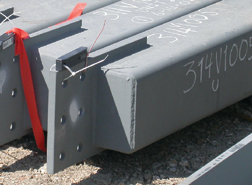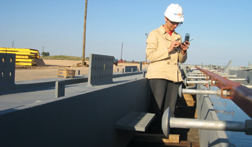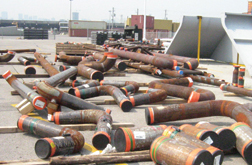Battles are being won in the campaign to use technology to improve construction productivity. Project managers, craft workers, fabricators and researchers feel the opportunity in their bones. And now, thanks to collaboration on field trials, they are beginning to capture data to prove it.
 Bechtel/CII Research Team |

Saiedeh Navabzadeh Razavi Razavi, on site in Texas, is working to optimize the materials-tracking data system.
|
Two similar powerplant projects now under construction in Texas and Canada are examples of both the progress being made and the challenges analysts have in measuring that progress.
On both projects, construction of twin boilers was the test scenario, with advanced materials-tracking technology applied to one, and traditional methods to the other. A comparison of the impact of technology on productivity in building two identical projects was the goal. But the test was, to a certain extent, a victim of its own success.
The results in both cases were convincing, and now production implementation of the technology is under way. “Within two weeks we decided this is an amazing technology, and we started to use it in a different route than the academics would have wanted,” says Paul Murray, site manager on the Canadian project used in one of the trials. “We had two identical boilers,” he notes. “Once we saw the use of it, we weren’t going to let one boiler fall behind.”
Chips and Satellites
On both projects, researchers tested similar combinations of radio-frequency identification tags, global positioning systems and software to track hundreds of prefabricated components scattered across dozens of acres of laydown yards. The RFID and GPS tools worked so well that researchers had trouble maintaining the discipline of controlled experimentation and data collection. Crews were eager to jump from trial to production as quickly as possible.

Saiedeh Navabzadeh Razavi Finding pipe components for installation is tricky after they are unloaded and often moved repeatedly.
|
Industry groups, including the Construction Industry Institute, FIATECH—an eight-year-old industry consortium whose name stands for Fully Integrated and Automated Technology for capital facilities construction—and the National Institute for Science and Technology, are working to benchmark and measure productivity in construction. In both trials CII and FIATECH were chief sponsors, but the research team included about two dozen representatives from universities, institutes, construction firms and vendors.
The Rockdale, Texas, job is a project of Bechtel Construction Operations Inc., Frederick, Md. It is engineering-procurement-construction contractor on an open-shop, $750-million, twin-boiler, 565-MW, lignite-fired powerplant there. The materials tracked were the steel components of the support structure for one of the boilers.
The components were fitted with electronic tags. Their locations were tracked with GPS and RFID readers as the fabricator’s trucks unloaded them and then as they were shifted around the 25-acre laydown yard over time. Estimated positions were computed by software based on direct data collection, as well as on the basis of signals picked up, several times a day, as vehicles and trackers traveled about the site.
The steel for the other support structure was not tagged. Its parts were tracked the old-fashioned way, by hand, with paper maps and grid squares.
The trial was run from Aug. 1 to Oct. 19, 2007. It found the average time spent tracking down a component by the manual method was 36.8 minutes, while the automated system took 4.6 minutes. In addition, with the manual system, 9.52% of the components sought “were not immediately found,” versus only 0.54% percent of the automated searches. The cost of a failure to locate a critical component at the right moment in the project sequence could lead to a serious slowdown or even reprocurement. When that issue was considered, the researchers deemed the higher success rate very significant.
It was a really structured effort,” says Shrikant Dixit, construction automation manager on the project for Bechtel. “All the costs were captured.”
“We are taking this to the next step internally at Bechtel,” Dixit says. “I have started it on a few production projects using the more advanced versions of the technology.”
The Canadian test site was on a similar $700-million EPC job of SNC-Lavalin Constructors Inc., Bothell, Wash. It is building, with union labor, a 550-MW...

Post a comment to this article
Report Abusive Comment